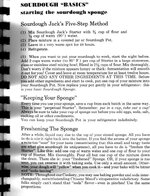- Messages
- 938
- Reactions
- 269
Okay, Gunner and Will from the Costco wheat thread got me to thinking 'bout getting some sourdough started and experiment with.
I don't know "nuth'n" about this so I'm going to ask a bunch of ignorant questions and hopefully my NWF brothers & sisters can get me on track...
Once I get a batch of sourdough started (I found this website as a place to begin my learning journey) <broken link removed> and hopefully this guy knows what he is talking about...
It is my understanding you only pull a portion of the starter and use it in a bread recipe. However this fella on this sourdough website sez to dump the entire starter into the recipe.
Can someone straighten me out - do I have to make a new starter each time I bake a loaf of bread or can I just use a portion? If so, how much is adequate to get the dough started?
I don't know "nuth'n" about this so I'm going to ask a bunch of ignorant questions and hopefully my NWF brothers & sisters can get me on track...
Once I get a batch of sourdough started (I found this website as a place to begin my learning journey) <broken link removed> and hopefully this guy knows what he is talking about...
It is my understanding you only pull a portion of the starter and use it in a bread recipe. However this fella on this sourdough website sez to dump the entire starter into the recipe.
Can someone straighten me out - do I have to make a new starter each time I bake a loaf of bread or can I just use a portion? If so, how much is adequate to get the dough started?













